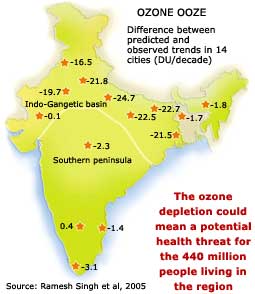/regions/political
Political
Map depicting areas prone to flooding in India
Posted on 19 Aug, 2009 03:48 PMThis map shows the regions in the country that are regularly affected by floods.
The major flood prone regions are Punjab, Haryana, most of the Gangetic plains including Uttar Pradesh, North Bihar and West Bengal, the Brahmaputra valley, coastal Andhra Pradesh and Orissa, and South Gujarat.
Rainwater harvesting basics: Filtering the water before storage and use
Posted on 19 Aug, 2009 03:29 PMOverview
Rainwater is amongst the purest water one can get distilled as it is by the sun. However, in a rainwater harvesting system, the water comes in contact with several surfaces, such as the roof or gutters. Its flow becomes possibly mixed with leaves or dust.
District level vulnerability to climate change: An IPCC assessment
Posted on 19 Aug, 2009 03:26 PMOn a scale of 5, from lowest to highest, this map shows the vulnerability of various districts of the country to climate change. The map shows many of these regions are doubly exposed to the risk of climate change.
Areas prone to floods in India
Posted on 19 Aug, 2009 03:19 PMThe total flood prone region in the country is 40 million Ha, of which about 32 million Ha, can be given protection. Until 1954, only 3 million Ha were protected, while as of 2004, about 15.8 million Ha has been protected. The average annual damage due to floods is estimated at Rs.
Incidence of fluorosis: Map showing states affected by fluorosis in india
Posted on 19 Aug, 2009 12:44 PMThese two maps indicate the percentage of districts affected by fluoride, in each state of the country and also gives data of the range of fluoride concentration in drinking water in each state.
Map: Fluoride in groundwater in Asia
Posted on 19 Aug, 2009 12:30 PMFor Asia, this map indicates the probability of occurrence of excessive concentrations of fluoride in groundwater, on a scale of high-medium-low.
Map: International Groundwater Resources Assessment Centre's global overview of salinity in groundwater
Posted on 19 Aug, 2009 10:20 AMIn India, salinity has three types of genesis - one, by dissolution (areas concentrated in Kutch, North Rajasthan and bordering Punjab, South Rajasthan and bordering areas of Madhya Pradesh and parts of Western Uttar Pradesh; two, by irrigation (areas concentrated in the Deccan Peninsular region of Andhra Pradesh, Karnataka and Tamil Nadu) and parts of Orissa and West Bengal; and three, by late
Rainwater harvesting basics: How to direct roof top rainwater into the sump
Posted on 19 Aug, 2009 10:00 AMOverview
International Groundwater Resources Assessment Centre's trans boundary aquifers of the world
Posted on 18 Aug, 2009 05:53 PMTrans-boundary aquifers (TBAs) of the world: This map shows the present state of information regarding the occurrence and extent of TBAs world-wide. The intention of the map is to provide a global overview of these important shared water resources and to encourage their further assessment.
In India, TBAs are located on the India-Pakistan, India-Nepal and India-Bangladesh borders.
